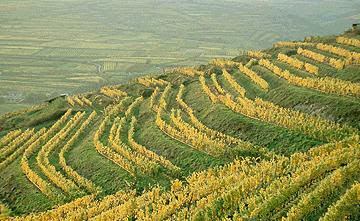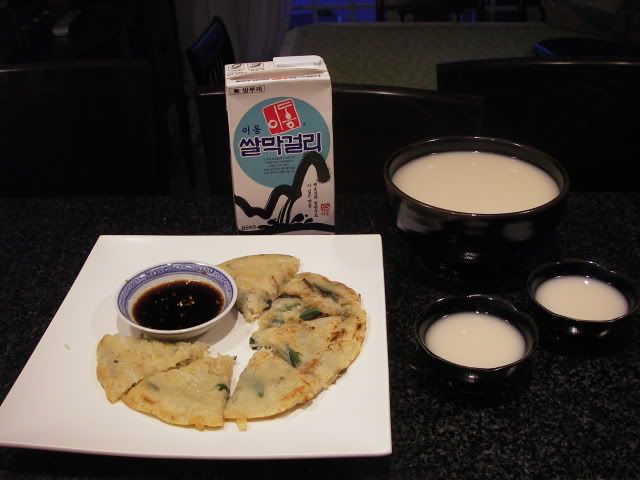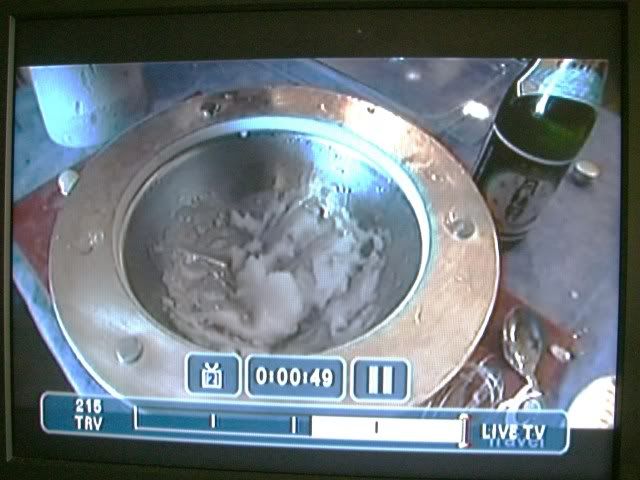
Last night, R. and I had the opportunity to meet Willi Bründlmayer in NYC. Pretty excited for this, as we've been drinking quite a few of his wines recently, all of which had raised questions for me. Apart from formal tasting dinners on other nights, Herr Bründlmayer was hosting an informal tasting at Atria. I had contacted the restaurant to get the details, to explain that we would be driving up from Philadelphia, so our arrival time was not certain, and that R. was a vegetarian, so any help in that direction would be appreciated. Well, it turned out to be quite the evening.
First of all, parking karma was in full effect, as we found a spot right at the door of the restaurant. Going in, we were surprised to see that there were only a few people present, it was never more than 7 of us. Herr Bründlmayer spoke of his family, his land, and of course his wines. A wonderful storyteller. And of course, we tasted his wines.
2004 Sekt - smoky but restrained nose, hints of black pepper. Medium+ body, spritz, quinine, lentil, light toast. Crisp but juicy, a blend of Pinot Noir, Pinot Gris, Pinot Blanc, Grüner Veltliner and dosed with a Chardonnay sweet wine. I mentioned that we had recently tried the '95 vintage of this wine, a very nice bottle, and he said we were lucky to have a good bottle, as not all corks have held up so well.
2005 Riesling Zöbinger Heiligenstein "Lyra" - pretty nose of white flowers, apples, pear. Rich and viscous, slate, oriental spice, and a pleasant bitter finish. A bit round at this time, which was surprising. I mentioned the '92 Riesling Zöbinger Heiligenstein Alte Reben (the provenance of this vineyard makes for a truly delightful story) we'd had for New Year's, how lively and fresh that still seemed, and he was absolutely thrilled, agreeing that it was an exceptional wine. I mentioned feeling torn about diving right back into our last remaining bottle, but Herr Bründlmayer left no doubt as to his opinion - "go for instant gratification!" He also explained his preferences for his wines - upon release for analytical drinking, a minimum of 7 years for contemplation. But, if it's for an occasion where wine is merely a social lubricant, 3-4 years of age, a quiet period for his wines. He explained that in his opinion, his wines paired best with food at this age.
N.V. Rose Sekt - technically a non-vintage wine, but made only with fruit from the 2005 harvest, the first release of this wine. Equal parts Pinot Noir, St. Laurent, and Zweigelt, dosed with a St. Laurent "grappa." A wonderful wine - bright, red fruited nose, but on the palate, smoky, herbal, meaty, lots of mineral and earth, great presence, very delicious.
2002 Grüner Veltliner Ried Käferberg - aged in acacia barrels, which was confirmed as the origin of the creamy, honeyed tones in this wine. Quite fat and viscous, nose of meadow flowers and grass, complemented by herbal and bitter notes on the palate. Round, with a touch of acidity on the back end, particularly as it warmed up. Really not my preferred style of G.V., but I can see its appeal.
2003 St. Laurent Ried Ladner - came across slightly differently than when I had this with J. and S. in Kyoto last month, more complex - on the nose, baking spice, brown sugar, leather and funk, and on the palate, tomato juice, berries, spice, even a bit of beefiness. More enjoyable, but still missing that "wildness" I'm used to from the Burgenland St. Laurents.
So, this was a major question I had - this is the first Kamptal St. Laurent I've had - most are from Burgenland, and I wanted to know why. According to Herr Bründlmayer, St. Laurent was once the primary red varietal of the region, but economics led to pulling out these vines in favor of riesling and grüner veltliner. On the other hand, Burgenland, the natural home to Blaufränkisch, was apparently looking to diversify away from this tannin monster. Justly famous for the botrytised dessert wines, but not successful with dry whites, they took to St. Laurent.
Now, some years ago, Herr Bründlmayer had heard that St. Laurent was in danger of becoming extinct in Kamptal, and he took it upon himself to start working with this varietal. He noted that St. Laurent is highly susceptible to botrytis (which is a famed feature of Burgenland), and that despite the Kamptal's high humidity, it is in his opinion a better climate for the grape. For now, I still prefer the Burgenland versions, but I'm interested to see how this progresses. Of course, now I have to wonder, what is the natural expression of this grape?

Zöbinger Heiligenstein
So these were the wines of the tasting. Lots of interesting conversation followed on, talking about various trends in winemaking - thinning, whole cluster fermentation, hand-tilling versus machine, and so on. The one that got a wee chuckle though was irrigation - turns out Herr Bründlmayer is the officer in charge of the Heiligentstein Irrigation Society and makes the decision on when to turn on the taps!
A wonderful, wonderful evening! But, wait, there's more! As we were getting up to leave, Herr Bründlmayer, Atria's wine manager, and Terry Thiese's portfolio manager asked us if we would join them for dinner (they said that since we were coming up "all the way" from Philadelphia, they wanted the night to be special for us!) Dinner was at Kurt Gutenbrunner's Wallsé - two Michelin stars, a fully Austrian menu and, with the exception of Champagne, a 100% Austrian wine list. Herr Gutenbrunner joined our dining party, and ensured fully vegetarian courses specially prepared for R. as well.
To start, something bubbly, but I didn't quite catch the name, might have been the N.V. Steininger Sekt - we got turned around driving to the restaurant, so they'd already jumped in. Never mind - parking karma still in effect, as we again got a spot directly in front. Some grizzled fellows sitting at an outside table, but apparently expecting us. Turns out it was the chef and a friend. On to the first course.
For R., a Boston lettuce salad with pumpkin seeds, radishes, and kürbiskernöl - Styrian pumpkin seed oil (one of my favorite "secret weapons" in the kitchen). Herr Gutenbrunner explained that when he opened Wallsé, he wanted to make a simple salad that reflected the fresh garden salads of his youth - greens and pumpkin seeds. Such a simple, but really delicious preparation.
For me, it was ramps soup with scallop ravioli, paired with the 2007 Hiedler Grüner Veltliner Thal, quintessential wine - lentils, smoke, mineral, stone-fruit pits, white flowers and white pepper, crisp and lively, little satellites of flavour orbiting around, served in the Riedel Sommelier G.V. glasses. Lovely glasses, chartreuse-green stems. Herr Gutenbrunner explained that Max Riedel hand carries these to him, and also that a certain musical guest had an "unforgiveable" habit of putting ice cubes in his wine and breaking these particular glasses - so much so, he's been cut off from their use.
Next course was a medley of mixed vegetables for R., and for me, I believe this was a grilled trout with creamed spinach, diced apples and pine nuts, paired with the 2005 Spaetrot Gebeshuber Grosse Reserve, a blend of zierfandler and rotgipfler, aged in oak barriques. From Gumpoldskirchen! I say (!) because we were talking about this village at the tasting. A lovely wine, nose and palate in harmony - smoky, cherry(!) notes, pear, flowers, honey, petrichor, and a touch of vanilla. Delicious, and not shy. Surprisingly good with the trout, very impressive!
For mains, R. had rosti and white asparagus (looking for soul food, Austrian style?), while I had seared monkfish with ramps risotto and morels. Paired with the 2005 Graf Hardegg Viognier from the Weinviertel, and apparently the only grower/farmer of viognier in the country. Total plantings of 1 hectare. Quite a clean, rich nose, stone fruit, honey, flowers, hints of vanilla. Round, viscous, rich, but not at all cloying, just enough leanness.
Finally, dessert. The things Austrians do with chocolate, it should be criminal! Time to go home (despite protestations that we should spend the night and hang out). All in all, a seriously top-notch evening! Dinner was an unexpected surprise, great conversations, a wonderful inside look at a restaurant of this calibre, and some very engaging personalities. Will definitely visit Herr Bründlmayer next time we're in Austria, and we'll certainly be back to Wallsé, I don't think Herr Gutenbrunner will forgive us if we don't!







